Murray Gillespie
Wapusk National Park
Murray Gillespie made his first of numerous visits to Churchill and the surrounding Hudson Bay Lowlands in 1972. Many things have changed since that first visit including the designation of a large tract of the lowlands as Wapusk National Park in 1996. Designating this unique lowlands area as a National Park provided new and important protection for the land, its wildlife, and especially for the culture of people that have used the area both historically and present day.
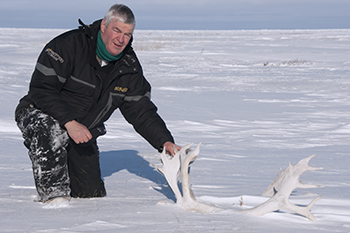
© Murray Gillespie
The Hudson Bay Lowlands had been recognized as an important area for wildlife including polar bears, caribou and Canada geese. In the early 1970s a wildlife research station (Nester One) was established just south of Cape Churchill and its primary role was to support research and management of the Eastern Prairie Population of Canada geese. Studying the large numbers of nesting geese required that researchers hike across the wet tundra and beach ridges to visit nests and count geese. In his role as the provincial game bird manager, Murray spent a lot of time at the Nester One Research Station and the adjacent coastal areas of the lowlands. The station started out as a canvas-covered wooden Quonset-style hut and though these structures were commonly found in the North, they had some shortfalls.
Namely, the insulated fabric did not withstand the curiosity of wandering polar bears. Even though researchers ensured no food was stored in the hut, lingering smells attracted these predators anyway, often resulting in a nasty surprise upon arrival.
“It got ripped up,” chuckled Murray, who made his first trip to Nester One in 1973.
While the electrified fence, roughly 1.8 metres (six feet) in height, surrounding the station was generally effective, the sheer volume of snow occasionally rendered it useless.
“The problem was in the winter or in the spring, when you were there, snow would be drifting and it would drift across the Quonset,” Murray recalled. “As you can imagine, if you were at the Quonset hut and you were looking northwest, you couldn’t see a tree or anything for shelter from the winds.
“You have all the wind coming from that direction and there’s nothing to stop it. It picks up snow until it gets to the camp and you have something like a building (in the way). It drifts the snow in behind it until the depth of the snow is level with the roof.
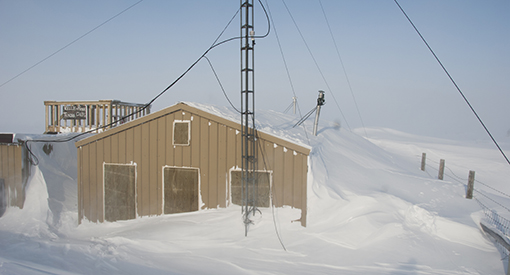
© Murray Gillespie
“That happened each winter with the Quonset hut, and what it meant was if a polar bear was passing by in the spring, or midwinter, they could easily walk on the hard-packed snow right over the top of the fence and onto the Quonset hut itself.”
There were multiple occasions where a bear bounded onto the roof with assistance from the snow drift, though one of Murray’s most memorable recollections came when he was at the camp accompanied by a grad student from the University of Wisconsin in the mid-1970s.
“One night, we heard the crunching on top of the Quonset because the snow was level with the roof” Murray recalled. “Something was walking on it, so we opened up the door and fired a couple of shotgun shells up in the air.
“The bear ran off into the dark to the bay but we didn’t sleep well the rest of that night.”
Nester One improvements
As the years passed, Murray helped lead improvements to Nester One that made it more habitable for visiting researchers.
The first addition was a separate insulated kitchen building for cooking. Carrying water with pails was upgraded by a gas pump and a long fire hose to a nearby lake. Eventually, the Quonset was removed and replaced with a new bunkhouse structure complete with bedrooms and even a boardroom for presentations.
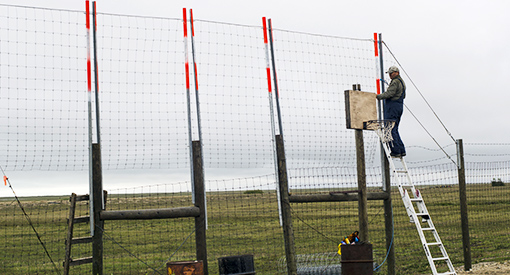
© Murray Gillespie
Murray worked with an engineer to help bear-proof the bunkhouse, including installing roof trusses closer together than usual and installing 3/4-inch plywood in addition to metal roofing.
“He assured me that if a bear walked on it, the weight would not break through the roof,” Murray recalled. “Bears did get on the roof but the heavy structure supported them well and no bears were able to break through; it worked well.”
In the late 1980s, a new 2.4-metre (eight-foot) fence was installed around the facilities, with another 30 centimetres of barbed wire on top to bring the height to about nine feet.
However, in some years bears could still use snow drifts to overcome the barrier, so a 5.2-metre (17-foot) fence was built on the windward side to halt their entry once and for all.
Digging out
The snow dumps provide another issue that can’t be rectified with taller fences or new buildings: the necessity to dig out the camp.
Murray recalled that, upon arriving by snowmobile, there was no opportunity to settle in; it would often be necessary to take a few hours to dig down two metres just to access the interior.
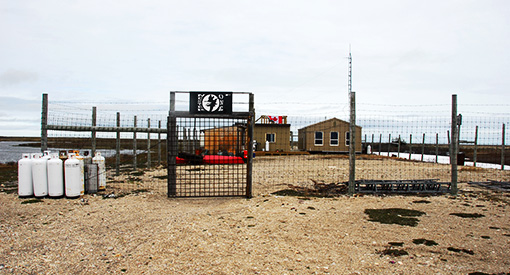
© Murray Gillespie
“It might take you a few hours to shovel it out to get to the bottom of the door,” he said. “The snow often drifted over the Quonset to a level where just a few inches of the roof was visible sticking out of the snow drift. Once you shoveled it out you’ve got a way in and out of the building.
“Fortunately, the way the Quonset was designed, the doors opened in, because in the morning, if you had a strong wind, your trench was most likely filled in by a drift. You’d open the door and you’re faced with mostly snow, so you have to crawl out and shovel that snow again.”
Keeping the building warm provided its own challenges, as visitors had to find and dig out fuel drums stored at a nearby beach ridge (so they would remain visible). They would then roll them over the snow back to Nester One and use them to power the furnace.
Travel time
Getting around could be a harrowing experience, as hiking or riding in a helicopter or small plane provided its share of white-knuckle moments. Snowmobiling out to Nester One was no Sunday cruise, either, especially on uncomfortable machines in bone-chilling temperatures without the benefit of GPS. It didn’t help that researchers often had to travel in near white out conditions.
“You just got familiar with the beach ridges and any kind of the landscape feature that would tell you where you are,” Murray said. “That’s how we would often navigate.”
The snowmobiles would regularly freeze up, though applying boiling water to the carburetor often did the trick.
Fond memories
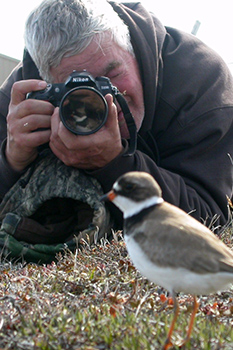
© Murray Gillespie
Nester One was originally built to support the study of Canada goose populations, a major part of Murray’s focus as the provincial Game Bird Manager, along the Hudson Bay coast. Murray worked for the Province of Manitoba for more than 36 years, retiring in 2007, and served on the Wapusk Management Board for several years starting in 2009.
In his role as the Game Bird Manager, Murray was responsible for tracking bird populations across the province to ensure they stayed at acceptable levels. He worked with his counterparts as part of the Mississippi Flyway Council, which includes states included in the migratory paths of the bird species, all the way down to the Gulf of Mexico.
Being at Nester One provided the opportunity to do more than just research one’s own area of study. Researchers from different projects would often share the space and their experiences. Murray recalled meeting renowned polar bear researcher Dr. Ian Stirling and even accompanying him on a bear-tagging expedition.
As an avid photographer, Murray was afforded the opportunity to hike while seeking nesting birds. On those excursions, he could snap photos of everything from wildlife to landscapes to cultural resources in the area. Having those shots is hugely important for Murray and for the history of the area.
“When I see a picture, I don’t just think, ‘Oh, that’s a nice picture.’ I’m back there. I see it and I understand it. I get excited,” he said. “I can look at the same picture many, many times and I still get excited to see that picture and relive the experience.”
In addition to wildlife research, the Nester One camp is currently used to support educational student programs and to provide safe field accommodation for many researchers and Wapusk National Park staff.- Date modified :